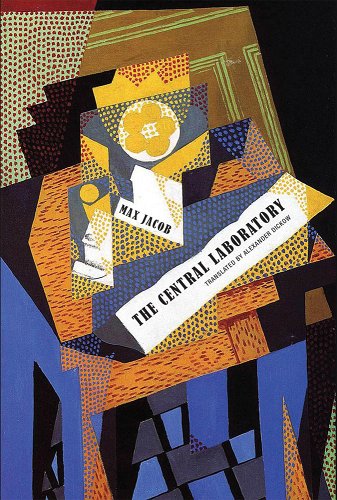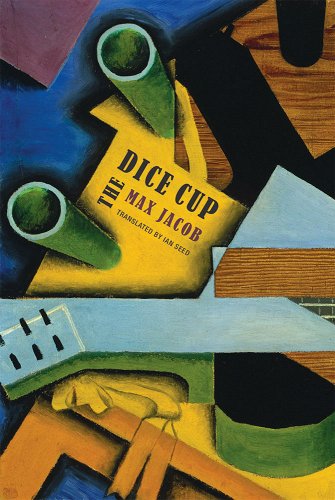The Central Laboratory
Max Jacob
Translated by Alexander Dickow
Wakefield Press ($22.95)
The Dice Cup
Max Jacob
Translated by Ian Seed
Wakefield Press ($19.95)
by Patrick James Dunagan
With only relatively brief selections of work readily available to Anglophone readers, the French poet Max Jacob, who died of pneumonia in a Nazi internment camp in 1944, has nonetheless long held an exalted status. These new translations of two of Jacob’s major collections should be recognized as welcome and essential: The Dice Cup (1917), Jacob’s unprecedented contribution to the development of the prose poem, and The Central Laboratory (1921), a collection that spans nearly two decades, together encompass most of his early poetic work. As recounted in Roseanna Warren’s enjoyably thorough Max Jacob: A Life in Art and Letters (W.W. Norton, 2020), this extraordinary flowering was buoyed by Jacob’s friendships with Picasso, Apollinaire, and many others in the Parisian avant-garde—though he was often at odds with his fellow groundbreakers as well, such as his on-again, off-again prose poem rivalry with Pierre Reverdy.
Born in 1876 into a bourgeois ethnically Jewish family in Brittany, Jacob scorned provincial mediocrity by absconding to Paris. There, he embraced the artistic city life that filled small streets and neighborhood hovels. Later in life, Jacob moved through the echelons of the upper class, mingling with art dealers and other patrons. Inner conflict about his homosexuality may have played a part in his deeply invested conversion to the Catholic faith, though he claimed it was due to a mystical vision. With Jacob’s enthusiasms as constant as his general dissatisfaction, it’s no wonder his poems display the influence of these shifting life experiences, often at a dizzying pace. As translator Alexander Dickow notes in his introduction to The Central Laboratory, “Jacob cannot act as unequivocal role model or poster boy for any particular identity: he is too full of contrasts and contradictions for that”; as a result, his “extraordinary life has long overshadowed his work.”
The frenetic shifting throughout The Central Laboratory—from line to line in individual poems (with an abundance of esoteric references and wordplay) and between forms from poem to poem (ballads, nursery rhymes, experimental collage)—continually surprises and challenges the reader. For instance, consider:
Perigal-Nohor
Someone’s patched up the azure of my sky
My nuptials had two lions standing by
And then Saint Catherine lifted her blade
To prune my honey-colored shrubs in braids—
Two castles on which little towers dwell—
The little castle tower’s scrofules swell.
It’s all that was left in this capitol
With bits of garden scattered here and there
And we could see your coifs of lace as well
Madame Adamunzipper
The color of kipper
Madame Mirabeau, Madame Mirabelle
Nebuchadnezzar’s mother, truth to tell.
Now sailboats returned to this cathedral
One with gold and the other with coal tar
The third one catching fire carried Abelard
While the sea seemed somewhat vegetal
I write in letters that are capital:
I’ll never be but a novice in art
The novices’ necklaces we wear crowns
The one who’s crowned amounts to he who crowns.
Jacob moves freely between sense and nonsense, beautifying the confusing, and at times, he delights in nothing less than the joy of how words sound. Yet, there is also glorious hubris (“my sky”), cheeky insight (as in the closing claim), and a sparkling intellect throughout, all of which showcase Jacob’s depths as well as wordplay.
As can be felt in the inventive lines above, Dickow’s translation of the Laboratory is generally quite fine, though there are occasional odd decisions. “Barège n’est pas Baume-les-Dames!” becomes “Bombay is not Ramagundam!” which is defended in a footnote: “Jacob mentions Barèges, a town in Southwestern France, and Baume-les-Dames, a town in Burgundy. I felt that Indian names with similar sonorities and rhythms might be more evocative for Anglophone readers.” This might hold true for some Anglophone readers, but most would not recognize Ramagundam any more than Baume-les-Dames—and Jacob was naming French locales, after all. Why exoticize the work? In another instance, “La fenêtre: un cigare au coin de l’univers” is rendered as “Window: cigar that dangles from the cosmic lip”—a rather overtly poetic flourish for the clearer “cigar resting on the corner of the universe,” disrupting what would seem the more striking image Jacob perhaps intended of the universe as cosmic ashtray.
Though the prose poems in The Dice Cup might be less formally challenging for today’s readers than the dizzy verses in The Central Laboratory, Ian Seed’s new translations, like Dickow’s, provide an opening for digging deeper into Jacob’s poetics. Dickow leads the way, citing Robert Guiette’s 1976 critical study La Vie de Max Jacob based upon interviews with Jacob in the 1920s, noting how the poet “framed his poetics precisely in terms of ‘disappointment [déception]’” and took triumphant glee in how “the reader was slid from place to place until there was nothing left.” He goes on to describe Jacob’s work overall as “the art of sabotaging readers’ expectations, of producing doubt and disorientation, perhaps even sadness or a slight sense of having been jilted.” Indeed, given the relative comfort most readers feel when faced with a piece of short prose (as it may contain the hint of a narrative, characters and actions assigned to them, etc.), it is jilting indeed to have none of the comfortable associations of one’s reading experience go as expected. Take this short piece:
The House of the Guillotined
To Paimpol! You cross the hills in the evening. The roofs of the news houses in evening blue and sea blue. A room at the hotel for so many from the smart set. Now for a life of great pursuits. All these little bladders on the sidewalk come from pretend rabbits: a servant blows them up and we take a shot at them: there is but one true rabbit: he’s old and seated: “Where’s René?” “He puts in an appearance from time to time.” René puts rubber soles on his shoes to act out the role of the old rabbit, and we sit down at the table facing Paimpol, facing the port and the evening hills. There’s a lady who knows the hostess’s secret: “It was in Paimpol last year at this time that . . .” The lady rises, her eyes full of tears. What a scene!”
Of course, Jacob has no intentions of his poem aligning with readerly expectations. Paraphrasing Jacob’s own remarks, Seed relates how “The prose poem ‘transplants’ components of reality into a realm where we can ‘situate’ those components in relation to one another, offering us alternative versions of reality, which in this case is not something fixed and stable, any more than one’s personality is.”
With both collections, the intent is to throw the reader off balance and to have that experience offer delight. Dickow cites a 1907 letter of Jacob’s that draws an interesting contrast: “surprise is a stable state,” he writes, whereas “pleasure is in movement; the spectator must be tossed to and fro; aesthetic emotion is doubt. Doubt is obtainable through the coupling of that which is incompatible (and without producing stable surprise) . . . in poetry, interest is born of doubt between reality and the imagination . . . Doubt, that is art!” None of Jacob’s poems, whether in prose or rhymed verse, are intended to be too easily digestible; he intends to confound. Seed reminds us in a footnote that, “In his Art Poetique, Jacob famously declared, ‘Personality is only a persistent error.’” In his social life, Jacob continually presented a refreshed reimagining of his self to the various scenes through which he swirled. His poetry likewise remains dedicated to the constant reimagining of the world.
Click below to purchase these books through Bookshop and support your local independent bookstore:
Rain Taxi Online Edition Spring 2023 | © Rain Taxi, Inc. 2023


